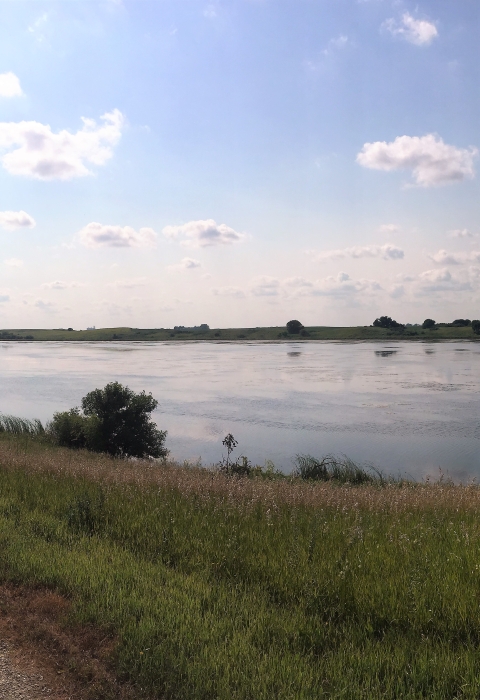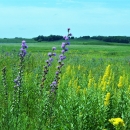About Us
Located in north-central Iowa in the southeast corner of the Prairie Pothole Region, Union Slough is all that remains of a pre-glacial riverbed. Actually, the area is a connection point, or union, between two watersheds - the Blue Earth River of Minnesota and the east fork of the Des Moines River. Before European settlement, the area was so level that the wind determined which way the slough flowed. Established in 1938 as a migratory waterfowl refuge, Union Slough National Wildlife Refuge provides critical habitat for native prairie and wetland wildlife in a landscape dominated by intensive agriculture. The refuge contains a diverse mix of habitats including marsh, prairie and river bottomland. Together, these areas total 3,334 acres that follow a seven mile stretch of Union Slough and a portion of bottomland along Buffalo Creek. The habitats of the refuge function as a regionally significant nesting and stopover site for migratory waterfowl and other migratory birds and support unique assemblages of resident plants and wildlife.
Our Mission
The mission of the National Wildlife Refuge System is to administer a national network of lands and waters for the conservation, management and, where appropriate, restoration of the fish, wildlife and plant resources and their habitats within the United States for the benefit of present and future generations of Americans.
The purpose of Union Slough National Wildlife Refuge is to serve as a refuge and breeding ground for migratory birds and other wildlife.
Every national wildlife refuge national wildlife refuge
A national wildlife refuge is typically a contiguous area of land and water managed by the U.S. Fish and Wildlife Service for the conservation and, where appropriate, restoration of fish, wildlife and plant resources and their habitats for the benefit of present and future generations of Americans.
Learn more about national wildlife refuge was created for a special purpose. Some were created to protect migratory birds, others to protect threatened or endangered species or unique habitats, while others fulfill another special purpose. All activities allowed on refuges must be evaluated to make sure each activity will not conflict with the reason the refuge was founded.
Our History
September 19, 1938 - Union Slough National Wildlife Refuge was established by Franklin D. Roosevelt, as a refuge and breeding ground for migratory birds and other wildlife.
1996 - Trumpeter swans were reintroduced to the refuge.
2012 - The first bald eagle nest is documented on the refuge.
2015 - River otters return to the refuge for the first time in at least 80 years.
2019 - Sandhill cranes return to nest at the refuge for the first time in more than 100 years.
Other Facilities in this Complex
In addition to the refuge, portions of two other units of the National Wildlife Refuge System are managed out of Union Slough National Wildlife Refuge - the Iowa Wetland Management District and the Northern Tallgrass Prairie National Wildlife Refuge.
The Iowa Wetland Management District is one of many wetland management districts within the Prairie Pothole Region that have been established to acquire, restore and manage habitat for waterfowl production and other migratory birds. The acquired tracts are known as waterfowl production areas and are managed collectively as a wetland management district wetland management district
A wetland management district is a U.S. Fish and Wildlife Service office that manages waterfowl production areas in one or more counties. Waterfowl production areas are small natural wetlands and grasslands that provide breeding, resting and nesting habitat for waterfowl, shorebirds, grassland birds and other wildlife. The Fish and Wildlife Service acquires waterfowl production areas under the authority of the Migratory Bird Hunting and Conservation Stamp Act, primarily using funds from the sale of Federal Duck Stamps. The Refuge System’s 38 wetland management districts comprise thousands of waterfowl production areas – almost all in the Prairie Pothole Region of the Northern Great Plains.
Learn more about wetland management district . The Iowa Wetland Management District is very different from other wetland management districts in that the Iowa Department of Natural Resources manages many of the waterfowl productions areas within it. Together, the state and the U. S. Fish and Wildlife Service have been able to develop large complexes of habitat for waterfowl and other wildlife species within the predominantly agricultural landscape in north-central Iowa.
The Northern Tallgrass Prairie National Wildlife Refuge was established in 2000 to address the loss of grasslands and the decline of grassland wildlife within western Minnesota and northwestern Iowa. Four tracts of this refuge are managed through Union Slough National Wildlife Refuge. The Iowa Department of Natural Resources assists with the management of three of these tracts.

